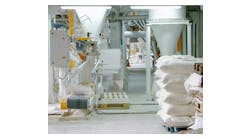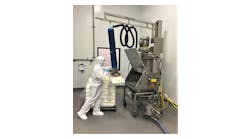Old and new challenges in pneumatic conveying
No matter how much time we spend solving problems and finding new ways to address challenges in pneumatic conveying, we never seem to run out of new challenges or the recurrence of old challenges that we have forgotten and treat as new ones.
Factors such as material cohesiveness, abrasiveness, and friability; particle shape; static buildup; and grinding aids have unpredictable effects on pneumatic conveying and can defy our calculations and tests and hinder our efforts to design an effective conveying system. But, while anticipating the headaches these factors can cause won't always solve the problem, it is better than ignoring them or being surprised when they create conveying headaches.
Material cohesiveness
Many materials can be cohesive. Very fine particles (less than 5 microns) tend to stick to each other, forming agglomerates and resisting flow or fluidization, not because they're moist but simply because the small particles are attracted to each other. The particles tend to adhere to the conveying line's inside wall, building up in layers, effectively reducing the line's inside diameter and thereby reducing conveying capacity and increasing pressure losses, which the system may or may not be able to handle.
Materials that contain fat or moisture can also be cohesive. Examples are cake mixes that contain shortening and powdered coal that has become damp during outdoor storage. Such materials are more likely to be cohesive if they also consist of fine particles. For instance, a material with a surface moisture above 0.5 percent and 100 percent of particles finer than 325 mesh can often have the consistency of paste. Conducting fluidization tests on the material in the early stages of system planning and design can identify these situations, allow for the validation of corrective measures and provide ample opportunity to address the fluidization in equipment selection.
Humidity can also cause a material to become cohesive and flow less smoothly. When a conveying system handles a material well in the winter but exhibits problems in warm summer weather, humidity is the likely culprit.
Sometimes we can find solutions, but those solutions are not always perfect. When humidity causes a material to become cohesive, one solution can be to use a dehumidifier to dry the conveying air, but this is expensive because the air must be continuously dried. A better solution to consider is a closed loop conveying system that recycles the dried conveying air to the system's start, avoiding the need for continuous drying.
Another similar, but less expensive, approach would be to find a nearby area of the plant that previously had its ambient air conditioned to remove excess moisture. Ducting air from this area to the conveying system air intake will provide dried air to the conveying system.
A solution for conveying a cohesive material in dense phase can be to design the system with adjustable pressure settings and air booster controls. Since a dense-phase system typically uses plant air supplied at 100-psig but operates at only about 30 to 40 psig, the system has a naturally "conservative" design (that is, higher air pressure is available than is used). Adjusting the system's pressure settings and air booster controls can allow you to increase the system pressure to handle the cohesive material.
But is there a way to accurately predict a cohesive material's behavior and design the conveying system for trouble-free operation when handling the material? In many applications, finding a way to successfully convey a cohesive material is a matter of trial and error.
This does not necessarily mean you have to use the system you have installed in your plant as a guinea pig. Independent test facilities are now available that can perform the necessary conveying tests to establish some performance characteristics that can then be used as part of the new system design.
While testing in your own facility would provide the exact conditions with respect to the material’s physical properties, lab testing offers more freedom to make changes and evaluate a larger envelope of performance without the fear of plugging lines and having to stop commercial production.
Material abrasiveness and friability
Abrasive and friable materials both produce wear problems. An abrasive material wears the conveying line, while contact with the conveying line wears a friable material. Frequently replacing worn system components to handle an abrasive material is a relatively small hassle. But not being able to sell friable material that has unexpectedly degraded during conveying or having material that is feeding a downstream production line become out of spec with respect to particle size and consistency, can be a huge problem. Yet the conveying effects of abrasive and friable materials defy theoretical prediction. Even after passing a test material through a pilot-plant conveying loop, it is difficult to predict the conveying line's service life or the degree of material degradation.
Particle shape
While particle shape affects a material's ability to be fluidized and conveyed, we often can't determine the extent of these shape effects when designing a conveying system to handle the material. The particles can vary from smooth, round spheres — which, when planning a conveying system, we typically assume is the shape of all particles — to cubes with sharp corners and flat surfaces. But there are other shapes as well, including flat platelets, which are difficult to dislodge once they settle in the conveying line, and stringy fibers, which tend to tangle and form bird's nests in the line. Although it is obvious that each of these particle shapes has a different drag coefficient that affects its conveyability, we have no calculation procedure that corrects for this variable. As a result, we often use a conservative pneumatic conveying system design, with higher air velocity and lower material-to-air loading, in an effort to keep the particles separated as they flow through the line. But be aware that such a design requires more costly system components and requires slightly more power to operate.
Static buildup
When a conveying system does not effectively move a material, especially when the material is plastic, static electricity (electrostatic charge) can be the problem. Using a well-grounded system is the first step toward a solution, but even grounding cannot guarantee that a static problem will not develop.
Static buildup problems are more serious in winter. In summer, higher humidity levels make the air more conductive, minimizing static buildup. But summer humidity does not always prevent static buildup. In one case of severe year-round static buildup in a conveying system, a user injected water vapor into the system's blower during the summer to increase the conveying air's humidity to its maximum level. While the increased humidity appeared to improve conveying, it did not completely solve the problem. Even worse, when winter arrived the water in the injection equipment froze, and the injection had to be stopped just when static buildup was at its worst.
Some users have taken test data from a completed pneumatic conveying system and compared it with theoretical calculations for static charge, calling the difference between the two the static charge effect. This is fine for calculating the static charge effect after the system is built, but how can we know this effect in advance? Correctly grounding the system and preventing sources of static buildup are good preventive steps to take but cannot entirely eliminate static problems.
Grinding aids
In size reduction applications, additives called grinding aids are often mixed with the material to be ground. The grinding aid facilitates size reduction so that the mill has to apply less grinding power. In one typical application, as little as 4 parts per million of grinding aid in Portland cement greatly reduces the amount of power the mill requires to reduce the cement. Grinding aids also affect pneumatic conveying. When Portland cement containing a grinding aid is transferred in a pneumatic conveying system, the system's conveying capacity increases, the pressure through the conveying line decreases, and for some time the cement remains more free flowing, even after storage in a silo, than cement without the additive.
This implies that it may be possible to find additives that could be mixed in small quantities with a material — without affecting the final product — to increase the material's flowability and the conveying system's throughput. The problem is that sometimes the inclusion or omission of an additive (even in quantities as small as 4 parts per million) causes a conveying system to perform other than as predicted.
Jack Hilbert is principal consultant for Pneumatic Conveying Consultants, LLC. He holds a BS and an MS in mechanical engineering from Penn State University, State College, PA, and has 50 years of experience in the application, design, detailed engineering, installation and operation of pneumatic conveying systems.
Pneumatic Conveying Consultants, LLC



